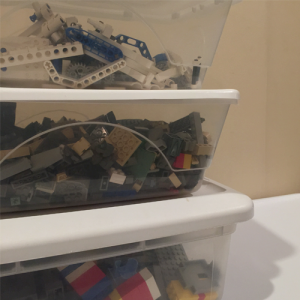How to Homeschool Multiple Children

Have any of you ever seen those booths where they turn on a high-powered fan and you try and catch the money that is swirling around you? That is probably the best visual I have for trying to homeschool multiple children simultaneously. Homeschool moms ARE the true superheroes!
To wit:
- They have x-ray vision – they can see those Lego® bricks hidden in a diligently “working” child’s lap.
- They have super hearing – they can hear the lid lifted on the cookie jar from 1,000 paces.
- They have supersensitive touch – they know from a brief pat who needs to be (1) changed, (2) consoled, or (3) disciplined.
The list is endless…
I have often thought of the lovely Norman Rockwell-esque photos or drawings of a peaceful mother sitting quietly on the sofa with her children gathered attentively around, listening as she instructs them. That is what I thought homeschooling my children would be like. My personal reality was much more like a Ronda Rousey tag-team event, with me sparring with one child while the others either looked on or drifted off to cause some sort of mayhem. Please do not misunderstand – I would not have changed my 21 years of schooling my children for anything, but a peaceful contented vision it was not.
All kidding aside, there is a real art to working with multiple children, and each day – in fact, each hour of the day – presents new challenges. Homeschool moms have to have a resiliency that far exceeds that of even the best Navy SEAL.
3 Tips for Homeschooling Multiple Children
I would like to share three ideas to help you homeschool multiple children of any age or circumstance.
Let’s take a look at the players in the game. If your children are close together in age, then there are some serendipities of being able to teach subjects together or engage in instruction that gives more than one child direction at a time. The reality is, however, that children are usually far enough apart in age that you have to plan differently for each child.
1) Plan Ahead
Planning ahead for your day can be the most valuable investment of your time. Look at each child’s curricula and decide what must absolutely be accomplished and what would be nice if it were completed. In my world, reading, math, and spelling were the must-haves. As you schedule, the ‘absolutely musts’ are the things that go on the calendar first. Schedule any appointments ahead if possible, and block off that time as “other”. Realistically look at your list and recognize that, on any given day, you are NOT going to be able to accomplish all that you plan but that even one accomplishment is a victory.

2) Keep Things Accessible
Plan to have things accessible to keep little hands busy. We had “doing boxes” in my homeschool room. They were special toys, puzzles, or games that my children could only access while I was busy with a sibling. Our favorites were the Barbie® Box, the GI Joe® Box, and a special Lego® box. You know your children best, so you can customize your boxes in all sorts of ways. The one rule I had was that one box of goodies had to be put away before someone was allowed to access another one.
3) Everyone Helps
I believe in forced altruism – help your children learn to help each other. Even a five-year-old can play puzzles with a younger sibling for 15 minutes while you engage in a Spelling You See lesson with an older child. I worked really hard to help my children learn to collaborate with each other in lessons. I insisted that they not compete. Sometimes you have to gently correct a child when they are speaking to a sibling, but I always felt that competition between siblings was dangerous, and I would much prefer them to speak words of encouragement to each other.

Bonus Tip
I want to share with you a fantastic idea I ran across at a homeschool convention. This lovely lady, Sarah Janisse Brown, is a homeschool mother of ten (!) who has turned her talents to helping all of us enjoy the task of homeschooling more. I LOVED her ideas in Mom’s Fun-Schooling Handbook. She takes the idea I have spoken about for “doing boxes” and gives you a wide variety of examples to set your kids up for success. Her blog would definitely be worth a read.
Homeschooling multiple children is like riding a wave. If you can stay on top of the wave, it is fun and exciting. Occasionally the wave will smack you right down, and you end up with a mouth full of sand, but homeschool moms are the superwomen who get right back up and keep the endgame in mind. Remember, every day is a gift, and this time will pass swiftly.
Homeschooling 101 eBook
No one knows your child better than you. We trust parents, and we want you to have the confidence to make the right decision for your situation.
We have compiled this eBook to help you through your decision. You’ll learn:
- The History of homeschooling
- How to find your state’s homeschool laws
- The different styles of homeschooling
- Tips from both professionals and veterans
- Where to find practical and inspirational resources to improve your homeschool experience
Enter your information below, and we will email the eBook to you right away.
[hubspot portal=”20645761″ id=”55f761b0-b799-40eb-8bc4-415cd73b2257″ type=”form”]